Optic is one of the branch of physics which deals with the light and properties of it. We know that light shows both the particle and wave characteristics. However, in this unit we will learn the particle characteristics of the light. Some of the topics will be covered in this unit are; reflection and refraction of light, plane mirrors, concave and convex mirrors, reflection of light from the mirrors, prisms and behavior of light in different mediums.
Properties of Light
- Light shows both wage and particle characteristics.
- It can travel in vacuum and speed of light in vacuum is 300.000.000m/s
- Light consists of particles which are called as photons.
- People see objects with the help of light.
- Light interacts with the matter and according to the types of material it reflects or refracts.
- Reflection of LightReflection is the turning back of the light from the surface it hits. Incoming and reflected lights have same angle with the surface. If the surface reflects most of the light then we call such surfaces as mirrors. Examine the given pictures below. They show regular and diffuse reflection of light from given surfaces.
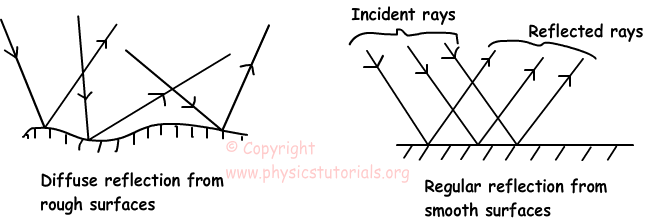 Laws of Reflection1.
Laws of Reflection1.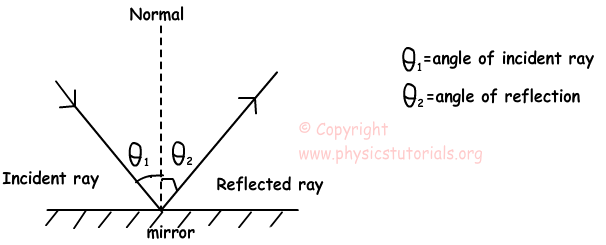 First law of reflection states that; Incident ray, reflected ray and Normal to the surface lie in the same plane.2.
First law of reflection states that; Incident ray, reflected ray and Normal to the surface lie in the same plane.2. Angle of incident ray is equal to the angle of reflection ray.Example: Find the angle of incident ray from the given information in picture?
Angle of incident ray is equal to the angle of reflection ray.Example: Find the angle of incident ray from the given information in picture?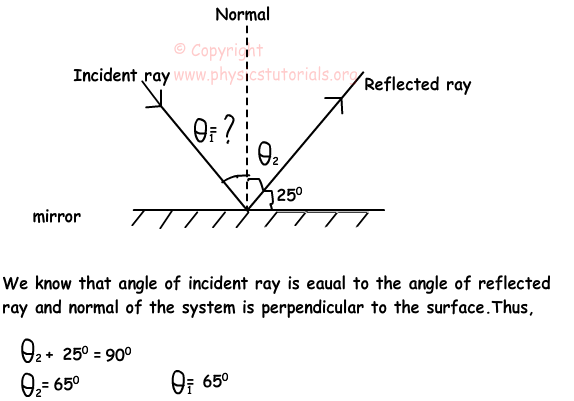
- Plane Mirrors and Image Formation in Plane MirrorsIf the reflecting surface of the mirror is flat then we call this type of mirror as plane mirrors. Light always has regular reflection on plane mirrors. Given picture below shows how we can find the image of a point in plane mirrors.
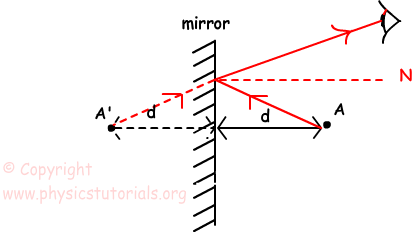 We have to see the rays coming from the object to see it. If the light first hits the mirror and then reflects with the same angle, the extensions of the reflected rays are focused at one point behind the mirror. We see the coming rays as if they are coming from the behind of the mirror. At point A’ image of the point is formed and we call this image virtual image which means not real. The distance of the image to the mirror is equal to the distance of the object to the mirror. If we want to draw the image of an object in plane mirrors we follow the given steps below. First look at picture and then follow the steps one by one.
We have to see the rays coming from the object to see it. If the light first hits the mirror and then reflects with the same angle, the extensions of the reflected rays are focused at one point behind the mirror. We see the coming rays as if they are coming from the behind of the mirror. At point A’ image of the point is formed and we call this image virtual image which means not real. The distance of the image to the mirror is equal to the distance of the object to the mirror. If we want to draw the image of an object in plane mirrors we follow the given steps below. First look at picture and then follow the steps one by one.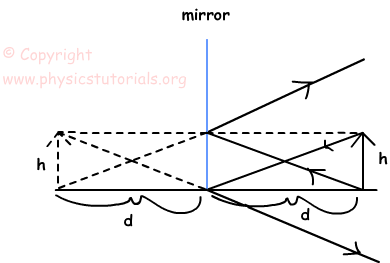 In plane mirrors, we use the laws of reflection while drawing the image of the objects. As you see from the picture we send rays from the top and bottom of the object to the mirror and reflect them with the same angle it hits the mirror. The extensions of the reflected rays give us the image of our object. The orientation and height of the image is same as the object. In plane mirrors always virtual image is formed.Example: Find the image of the given object.
In plane mirrors, we use the laws of reflection while drawing the image of the objects. As you see from the picture we send rays from the top and bottom of the object to the mirror and reflect them with the same angle it hits the mirror. The extensions of the reflected rays give us the image of our object. The orientation and height of the image is same as the object. In plane mirrors always virtual image is formed.Example: Find the image of the given object.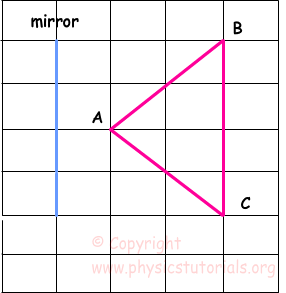 As I said before, image of the object is formed behind the mirror with the same distance of object. We draw first point A’ which is the image of point A, we placed it one unit away from the mirror, then points B’ and C’ are placed with the same way. We connect these 3 points and the image of object becomes formed. The dashed line in the left side of the mirror is our image.
As I said before, image of the object is formed behind the mirror with the same distance of object. We draw first point A’ which is the image of point A, we placed it one unit away from the mirror, then points B’ and C’ are placed with the same way. We connect these 3 points and the image of object becomes formed. The dashed line in the left side of the mirror is our image.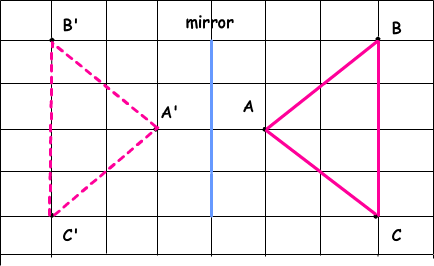 Moving Plane MirrorIf the plane mirror is moving with a velocity v, what would be the velocity of the image? Is it also moving with the same velocity of the mirror and what is the direction of the images velocity? We will try to answer these questions in this section.
Moving Plane MirrorIf the plane mirror is moving with a velocity v, what would be the velocity of the image? Is it also moving with the same velocity of the mirror and what is the direction of the images velocity? We will try to answer these questions in this section. If the mirror moves with a velocity of V then image of the object moves with the velocity of 2V with the same direction of mirror. Second picture shows the locations of the mirror and image after t seconds. As it seen from the picture, distance traveled by the image is twice of the distance traveled by the mirror since the velocity of the image is 2V.Now, we will examine the situation in which mirror is stationary and object moves with a velocity of V.
If the mirror moves with a velocity of V then image of the object moves with the velocity of 2V with the same direction of mirror. Second picture shows the locations of the mirror and image after t seconds. As it seen from the picture, distance traveled by the image is twice of the distance traveled by the mirror since the velocity of the image is 2V.Now, we will examine the situation in which mirror is stationary and object moves with a velocity of V. If the object moves with a velocity of V then image also moves with same speed but opposite in direction. Pictures given above show the motion of object and image. Second picture is the representation of locations after t seconds.Example: Find the velocity of the image of the car with respect to ground if both the mirror and car moves with a given velocities.
If the object moves with a velocity of V then image also moves with same speed but opposite in direction. Pictures given above show the motion of object and image. Second picture is the representation of locations after t seconds.Example: Find the velocity of the image of the car with respect to ground if both the mirror and car moves with a given velocities. If car moves with velocity 6V then image moves with -6V, we put “–“sign since image moves to the left. If mirror moves with velocity 4V to the right, then image of the car moves with the velocity 8V to the right.Velocity of the image=8V+ (-6V) =2V to the right with respect to ground
If car moves with velocity 6V then image moves with -6V, we put “–“sign since image moves to the left. If mirror moves with velocity 4V to the right, then image of the car moves with the velocity 8V to the right.Velocity of the image=8V+ (-6V) =2V to the right with respect to ground - Curved MirrorsWe call these types of mirrors also spherical mirrors because they are pieces of a sphere. If the reflecting surface of the mirror is outside of the sphere then we call it convex mirror and if the reflecting surface of it is inside the sphere then we call it concave mirror. There are some fundamental terms we should learn before we pass to the ray diagrams and image formation in curved mirrors such as principal axis, focal point, center of curvature, radius of curvature and vertex.
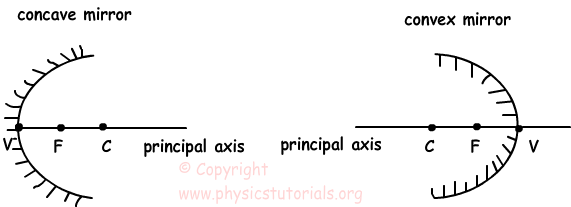 Center of Curvature: As you can understand from the name it is the center of the sphere which the mirror is taken from. It is denoted by C in the diagrams.Principal Axis: Line coming from the center of the sphere to the mirror is called as principal axis.Vertex: It is the intersection point of the mirror and principal axis. We show it with the letter V in ray diagrams.Focal Point: For concave mirrors and thin lenses rays coming parallel to the principal axis reflects from the optical device and pass from this point. For convex mirrors and thick lenses rays coming from this point or appear to coming from this point reflect parallel to the principal axis from the optical device. Another explanation for this term is that, it is the point where the image of the object at infinity is formed. It is denoted with the letter F or sometimes f in ray diagrams.
Center of Curvature: As you can understand from the name it is the center of the sphere which the mirror is taken from. It is denoted by C in the diagrams.Principal Axis: Line coming from the center of the sphere to the mirror is called as principal axis.Vertex: It is the intersection point of the mirror and principal axis. We show it with the letter V in ray diagrams.Focal Point: For concave mirrors and thin lenses rays coming parallel to the principal axis reflects from the optical device and pass from this point. For convex mirrors and thick lenses rays coming from this point or appear to coming from this point reflect parallel to the principal axis from the optical device. Another explanation for this term is that, it is the point where the image of the object at infinity is formed. It is denoted with the letter F or sometimes f in ray diagrams.
Radius of Curvature: It is the distance between center of the sphere and vertex. We show it with R in ray diagrams.
Concave Mirrors
We give the definition of concave mirrors in previous sections. Now we will examine the reflection of light from this type of mirrors and image formation in concave mirrors. Let’s start with the reflection of light with special examples.
1. In this example, ray coming parallel to the principal axis reflects from the mirror and passes from the focal point. As in the case of plane mirrors light obey the law of reflection. In this case normal of the mirror is the line coming from the center of the mirror. If you want to draw the reflection of any light you can use this technique. Draw your normal and with the same angle of incident ray reflect your light.
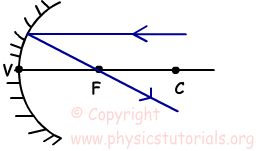
2. Ray coming from the focal point reflects from the mirror and goes parallel to the principal axis, as in the first situation.
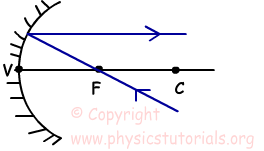
3. Ray coming from the center turns back on itself after reflecting from the mirror. As I said before line coming from the center of the mirror is the normal of that system and hits the mirror perpendicularly.
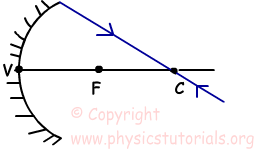
4. Ray hitting the mirror at vertex point reflects with the same angle it comes.
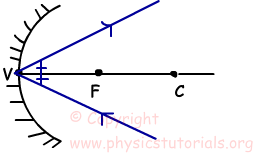
5. If the ray is not one of the special rays given above, then you should draw the normal of the system and reflect the light with the same angle as it hits the mirror.
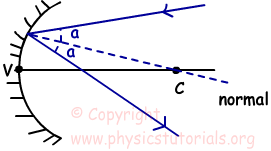
Example: Find the relation between the focal lengths of the mirrors given below.
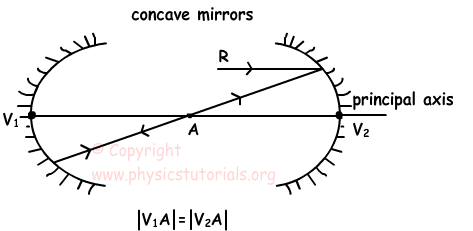
Light ray R comes parallel to the principal axis and reflects from the mirror 2 and passes from the point A. We know that rays coming parallel to the principal axis passes from the focal point after reflection. Thus, point A is the focal point of the mirror 2.
Ray coming from point A turns back on itself after reflecting from mirror 1, we know that rays coming from the center of curvature turns back on itself. So, point A is the center of curvature of the mirror1.

Example: Look at the given system, there is a concave mirror and plane mirror located on the focal point of the concave mirror. Draw the path of the ray and show how it leaves the system.
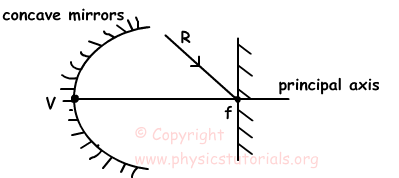
Ray coming to the plane mirror reflects with the same angle, reflected ray from the mirror comes to the concave mirror from its focal point and after reflecting from the concave mirror it travels parallel to the principal axis. It comes to the plane mirror with an angle 90º, it turns back on itself and follows the same path and leaves the system.
Image Formation in Concave Mirrors
While drawing images of the object we benefits from the special rays given above. We use them because we know the paths of them. Let’s start drawing images of the objects located in different parts of the mirror.
1. If the object placed at the center of the mirror, image is also formed at center, real, inverted and with the same size as object. To find this image we send two rays from the top of the object. One of them is parallel to the principal axis which passes from the focal point after reflection and second ray passes from the focal point and goes parallel to the principal axis after reflection. The intersection point of these two reflected rays gives us the location of image. As you can see from the picture green one is image of the object.

2. If the object placed away from the center of the mirror, image is formed between the focal point and center of the mirror. Properties of mirrors are, real, inverted and reduced in size.
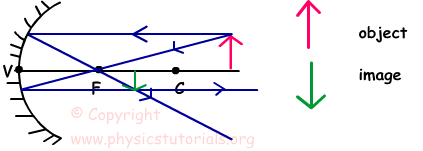
3. If the object placed between the focal point and center of the mirror, then image is formed away from the center. Characteristics of the image are; real, inverted and magnified in size.
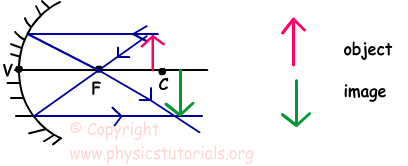
4. In this picture object is placed at focal point and as you can see reflected rays goes parallel to each other. In other words, they do not intersect in any point, thus we assume that image is formed at infinity.
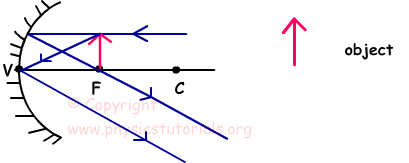
5. If the object placed between the focal point and vertex then virtual image is formed behind the mirror. Since the rays reflected from the mirror do not intersect, their extensions behind the mirror intersect and virtual image is formed. Image is magnified in size and erect unlike the real images.
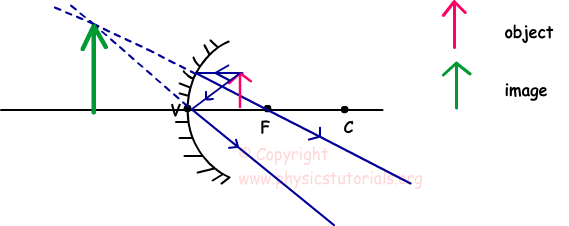
Example: Look at the given picture, If the distance between the object and its image is 120cm, find the focal length of this mirror. Image of the object is behind the mirror, erect and its length is three times larger than the object.
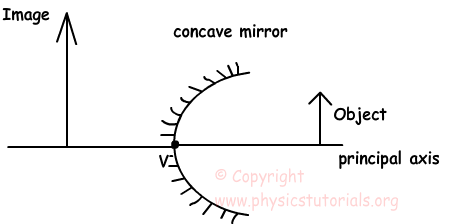
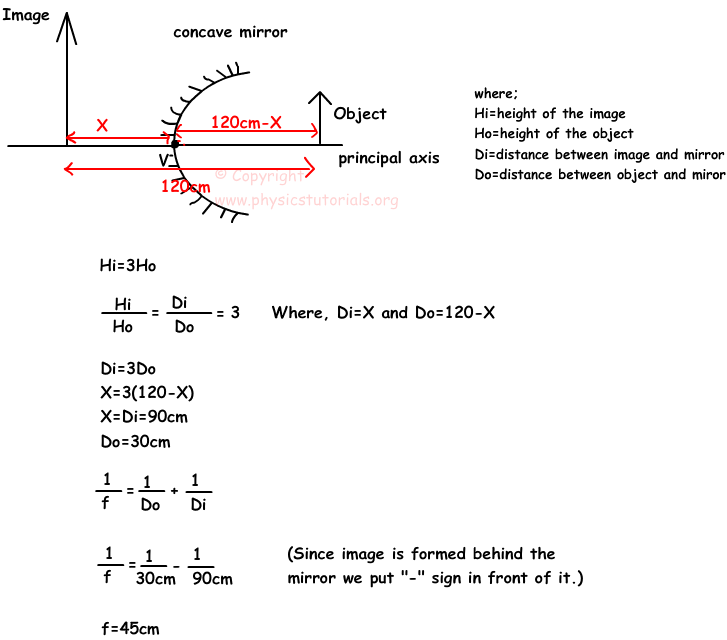
Example: We have an optical system including a concave mirror and a plane mirror in the picture given below. Object is located at point A; its first image is formed in plane mirror and second one is in concave mirror. Find these images of the object.
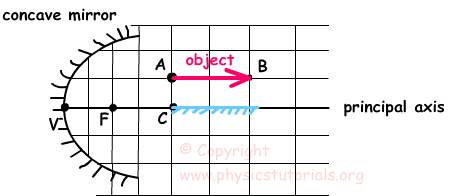
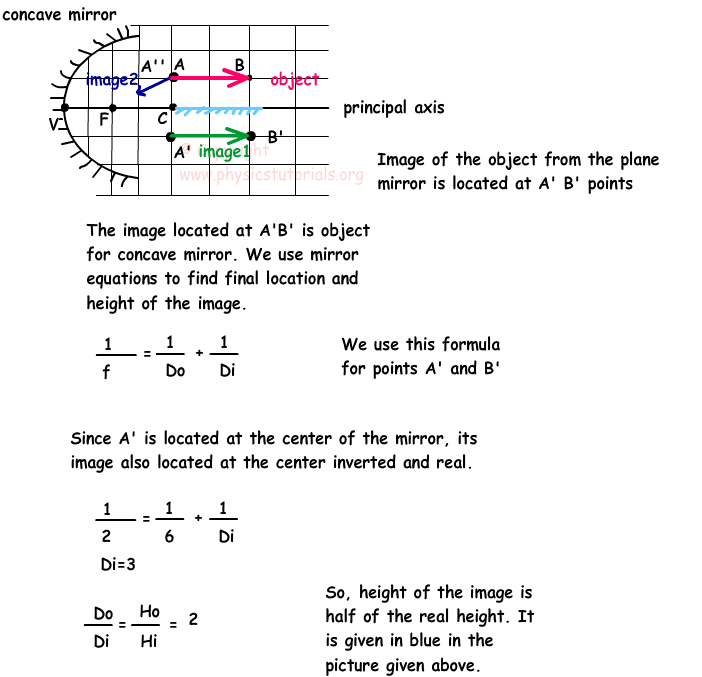
Convex Mirrors
We give the definition of convex mirrors in previous sections. Now we will examine the reflection of light from this type of mirrors and image formation in convex mirrors. Let’s start with the reflection of light with special examples.
1. In convex mirrors, ray coming parallel to the principal axis goes after reflection as if it comes from the focal point of the mirror.
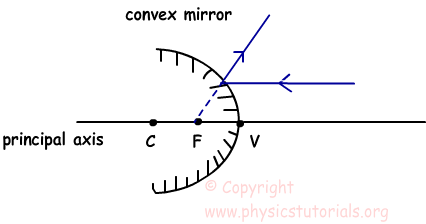
2. If the extension of the coming ray passes from the focal point, it travels parallel to the principal axis after reflection from the mirror.
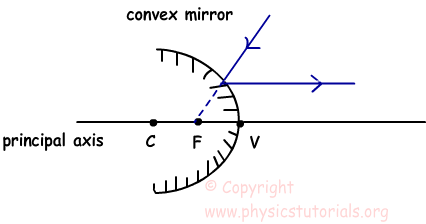
3. If the extension of coming ray passes from the center of the curvature, ray reflects from the mirror and travels on itself. As we said before line joining the mirror to the center of the curvature is perpendicular to the mirror and normal of the system.
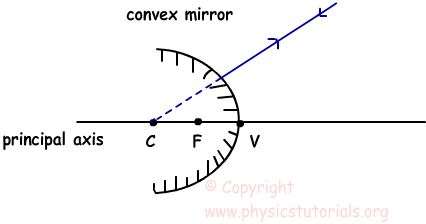
4. Ray strikes to the mirror at vertex, reflects from the mirror with the same angle it comes because, principal axis is the normal of the system.
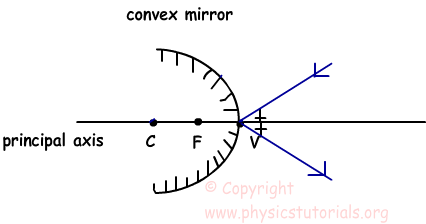
Example: Look at the path of the ray R in the given picture, f1 is the focal length of the convex mirror and f2 is the focal length of the concave mirror. Find the distance between then mirrors in terms of f1 and f2.

Ray coming parallel to the principal axis must go to the focal point of the concave mirror, after reflecting from the concave mirror ray strikes to the convex mirror and goes parallel to the principal axis. This shows us that; ray coming from concave mirror goes to the focal point of the convex mirror. Let me show these explanations on the picture.
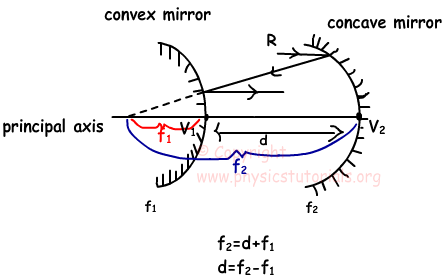
Image Formation in Convex Mirrors
While drawing images of the object we benefits from the special rays given above. We use them because we know the paths of them. In convex mirrors image is usually formed behind the mirror, it is virtual and erect. Location of the image is always between the focal point and vertex of the mirror. Look at the given pictures below, they show what I try to say.
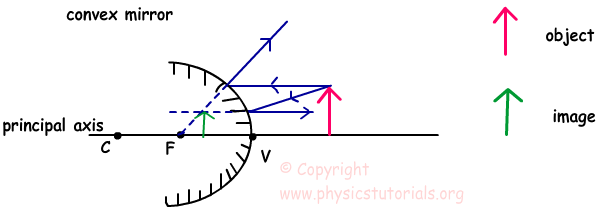
We send two rays from the top of the object. One of the rays is parallel to the principal axis and reflects from the mirror as it comes from focal point and the extension of the second ray passes from the focal point so it travels parallel to the principal axis after reflection. Behind the mirror, extensions of the two reflected rays intersect at one point at which image of the object is located. As you can see from the picture, height of the image is smaller than the object, it is virtual and erect. Now look at another example given above.
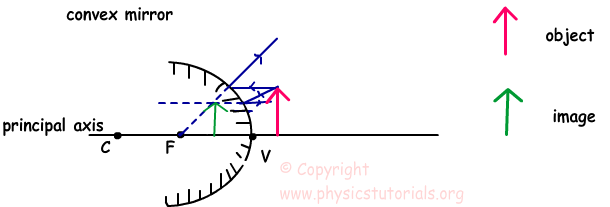
In this picture, object is closer to the mirror. Image is again formed between the focal point and vertex. However, in this case height of the image is larger than the situation given above. We can conclude that, closer the object to the mirror bigger the height of the image. But, don’t forget, image is always smaller than the object.
The last example is given below in which object is at infinity and image is formed behind the mirror at focal point like a point.
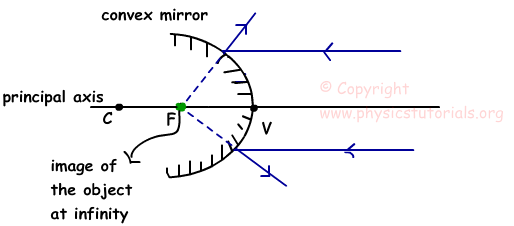
Example: Plane mirror and convex mirror are placed on same principal axis. If the focal length of the convex mirror is 12 cm find the distance d shown in the picture.
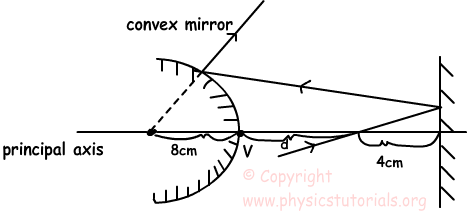
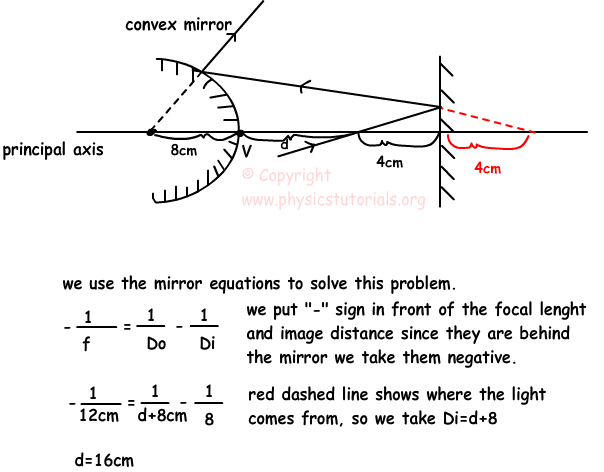
Mirror Equations of Curved Mirrors
We use the given picture below to derive the equations of concave and convex mirrors.
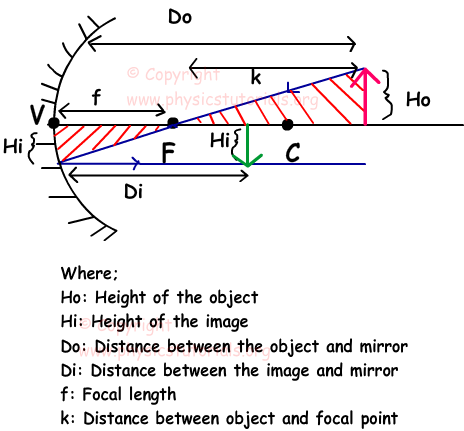
While deriving equations we use the similarities of triangles given picture above. We show them with red lines in the picture. I do not want to make confusion in your mind and write down the equations that I get from similarity of two triangles.

In this equation, we take the quantities positive if they in front of the mirror. In other words, if the object, image and focal point of the mirror are located in front of the mirror (like concave mirrors) we take them positive; if they are located behind the mirror (like convex mirrors) we take them as negative. In convex mirrors focal length is taken as negative since it is behind the mirror and in concave mirrors if the image is behind the mirror then we take it also as negative.

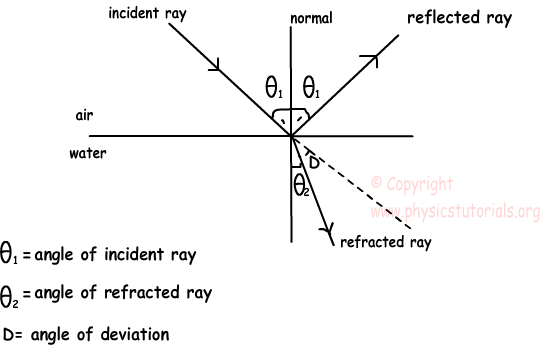
Refraction
As I said before light travels in a straight line in any homogenous medium. However, when it passes from one medium to another medium it 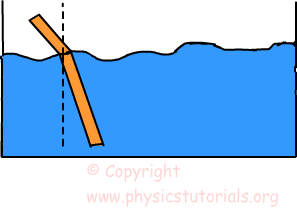 changes its direction. We call this change in the direction of light refraction. Since the densities of the mediums are different light travels with different speed in different mediums. Speed of light in vacuum is 300.000.000km per hour. You see the stick as it is broken in the given picture. It is the clear example of refraction of light. We find the amount of refraction by using the refractive indexes of the mediums. What is the refractive index? It is the ratio of the speed of light in vacuum to the speed of the light in given medium. Refractive index of medium A is given below;
changes its direction. We call this change in the direction of light refraction. Since the densities of the mediums are different light travels with different speed in different mediums. Speed of light in vacuum is 300.000.000km per hour. You see the stick as it is broken in the given picture. It is the clear example of refraction of light. We find the amount of refraction by using the refractive indexes of the mediums. What is the refractive index? It is the ratio of the speed of light in vacuum to the speed of the light in given medium. Refractive index of medium A is given below;
 changes its direction. We call this change in the direction of light refraction. Since the densities of the mediums are different light travels with different speed in different mediums. Speed of light in vacuum is 300.000.000km per hour. You see the stick as it is broken in the given picture. It is the clear example of refraction of light. We find the amount of refraction by using the refractive indexes of the mediums. What is the refractive index? It is the ratio of the speed of light in vacuum to the speed of the light in given medium. Refractive index of medium A is given below;
changes its direction. We call this change in the direction of light refraction. Since the densities of the mediums are different light travels with different speed in different mediums. Speed of light in vacuum is 300.000.000km per hour. You see the stick as it is broken in the given picture. It is the clear example of refraction of light. We find the amount of refraction by using the refractive indexes of the mediums. What is the refractive index? It is the ratio of the speed of light in vacuum to the speed of the light in given medium. Refractive index of medium A is given below;
Now we examine the refraction of light from two mediums. We assume the refractive index of air 1.

The drawing given above shows the angles of reflected and refracted rays. You may some confusion in your mind about the reflection of the light in refracting. However, I want to mention it here, when an incident ray passes one medium to another some parts of it is reflected from the surface of boundary and the rest is refracted. The amount of reflection is related to the difference between the refractive indexes of the mediums. Later in this topic we will see this detail.
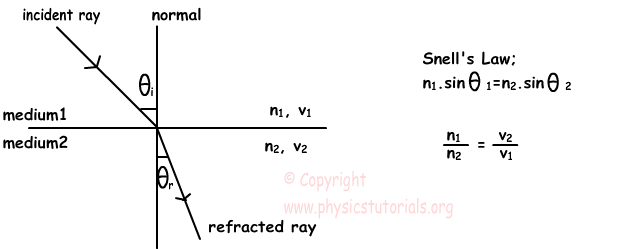

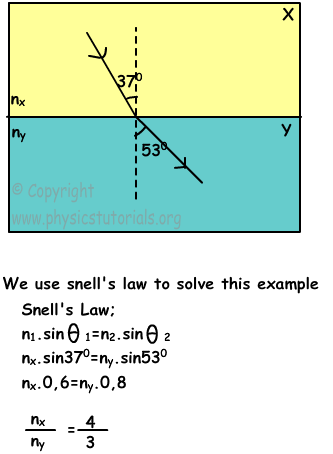

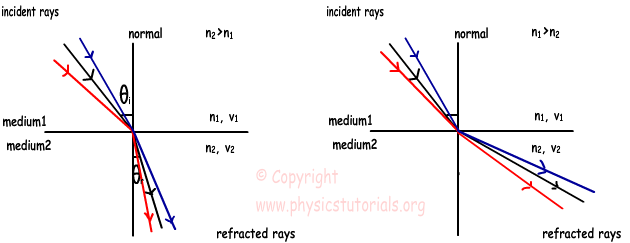
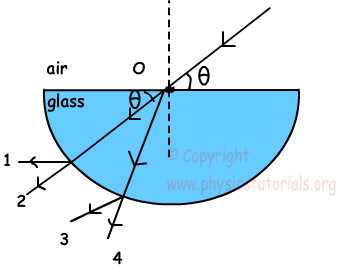
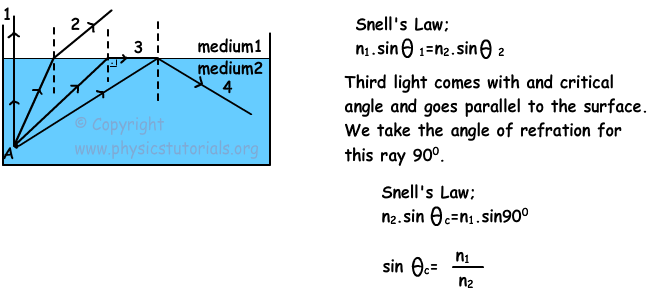

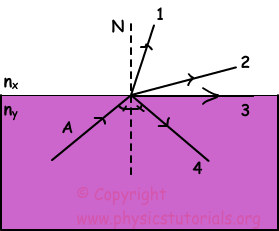
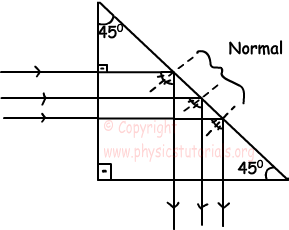
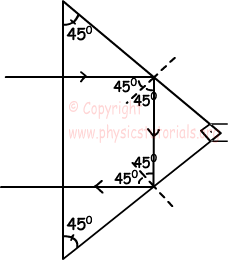

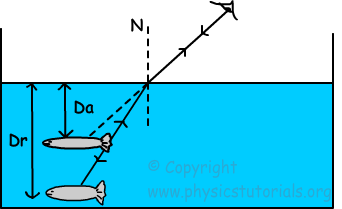
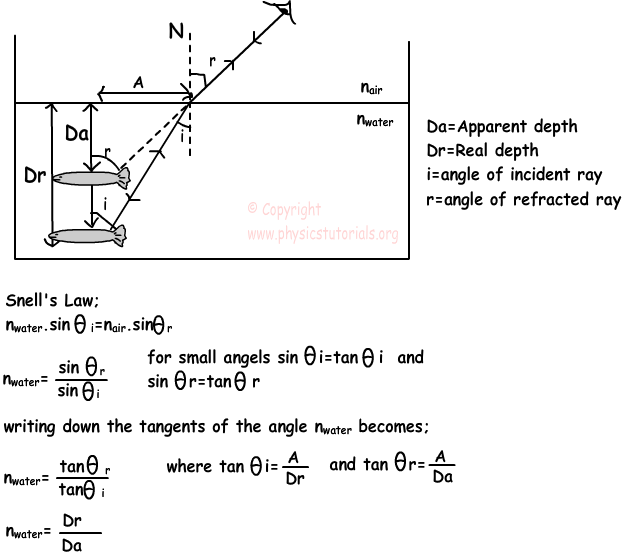

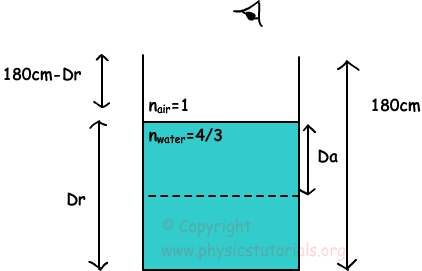













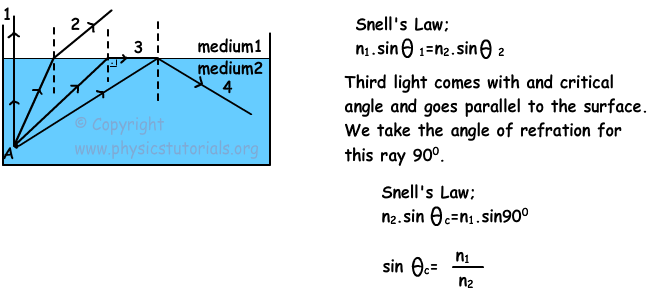

The Laws of Refraction
- Incident ray, reflected ray, refracted ray and the normal of the system lie in the same plane.
- Incident ray, coming from one medium to the boundary of another medium, is refracted with a rule derived from a physicist Willebrord Snellius. He found that there is a constant relation between the angle of incident ray and angle of refracted ray. This constant is the refractive index of second medium relative to the first medium. He gives the final form of this equation like;

Where n1 is the refractive index of first medium and n2 is the refractive index of second medium, v1 is the speed of light in firs medium and v2 is the speed of light in second medium.
Example: Find the velocity of the ray in a medium having refractive index 2.

Example: A ray coming from medium X is refracted as shown in the figure below while passing to the medium Y. Find ratio of the refractive indexes of the mediums. (sin37º=0, 6 and sin53º=0, 8)


- When we give the refractive index of medium you should understand that it is the relative refractive index of that medium.
- In general, if the density of the medium increases than refractive index of that medium also increases. However, of course there are some exceptions like water.
- Velocity of the light in a medium is inversely proportional to the refractive index of that medium. If the refractive index increases then velocity of the light decreases.
- If the light comes perpendicular to the boundary of two different mediums, it does not change its direction. Because it is on the normal line of the system. But, the velocity of the light changes since the density of the medium changes.
- Refractive index of the medium is also depends on the color of the coming light. For example, refractive index of the medium for violet colors is larger than the refractive index of the medium for other colors.
- The angle of refraction of the light coming from the medium having smaller refractive index is smaller than the angle of incident ray. Look at the given diagram that shows this relation.

Example: Find the path of the ray after refracting.

Ray coming from air to glass is refracted from the surface, thus 1 and 2 choices are eliminated. When the light comes to the boundary of the glass it does not refract since it comes from the normal of the system and goes in a straight line. Thus, it follows the path shown in 4.
Critical Angle and Total Reflection
Look at the given picture. Rays with different angles coming from the source at the bottom of the water filled glass, refracted from the 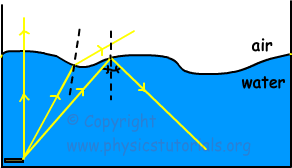 surface, reflected and directly pass to the second medium without any reflection and refraction. In the previous section we learned Snell’s law of refraction. According to this law; reflecting, refracting or directly passing of light to the other medium is depends on angle of incident ray and refractive indexes of the mediums. Here, you see that light coming from the medium having larger refractive index to the smaller refractive index. Thus, light refract away from the normal. According to the angle of incident ray, at one point it does not refract but goes parallel to the boundary of the mediums. We called this angle as critical angle. If the angle of incident ray is larger than the critical angle then it does not refract but it does total reflection. In the picture given above, first light is coming from the normal thus it does not reflect or refract; it passes directly to the second medium. Second light coming with an angle smaller than the critical angle, refracts and passes to the second medium. However, third light coming with an angle larger than the critical angle does total reflection and can not pass to the second medium.
surface, reflected and directly pass to the second medium without any reflection and refraction. In the previous section we learned Snell’s law of refraction. According to this law; reflecting, refracting or directly passing of light to the other medium is depends on angle of incident ray and refractive indexes of the mediums. Here, you see that light coming from the medium having larger refractive index to the smaller refractive index. Thus, light refract away from the normal. According to the angle of incident ray, at one point it does not refract but goes parallel to the boundary of the mediums. We called this angle as critical angle. If the angle of incident ray is larger than the critical angle then it does not refract but it does total reflection. In the picture given above, first light is coming from the normal thus it does not reflect or refract; it passes directly to the second medium. Second light coming with an angle smaller than the critical angle, refracts and passes to the second medium. However, third light coming with an angle larger than the critical angle does total reflection and can not pass to the second medium.
 surface, reflected and directly pass to the second medium without any reflection and refraction. In the previous section we learned Snell’s law of refraction. According to this law; reflecting, refracting or directly passing of light to the other medium is depends on angle of incident ray and refractive indexes of the mediums. Here, you see that light coming from the medium having larger refractive index to the smaller refractive index. Thus, light refract away from the normal. According to the angle of incident ray, at one point it does not refract but goes parallel to the boundary of the mediums. We called this angle as critical angle. If the angle of incident ray is larger than the critical angle then it does not refract but it does total reflection. In the picture given above, first light is coming from the normal thus it does not reflect or refract; it passes directly to the second medium. Second light coming with an angle smaller than the critical angle, refracts and passes to the second medium. However, third light coming with an angle larger than the critical angle does total reflection and can not pass to the second medium.
surface, reflected and directly pass to the second medium without any reflection and refraction. In the previous section we learned Snell’s law of refraction. According to this law; reflecting, refracting or directly passing of light to the other medium is depends on angle of incident ray and refractive indexes of the mediums. Here, you see that light coming from the medium having larger refractive index to the smaller refractive index. Thus, light refract away from the normal. According to the angle of incident ray, at one point it does not refract but goes parallel to the boundary of the mediums. We called this angle as critical angle. If the angle of incident ray is larger than the critical angle then it does not refract but it does total reflection. In the picture given above, first light is coming from the normal thus it does not reflect or refract; it passes directly to the second medium. Second light coming with an angle smaller than the critical angle, refracts and passes to the second medium. However, third light coming with an angle larger than the critical angle does total reflection and can not pass to the second medium.
Now we use Snell’s law of refraction and find the equation of critical angle.

Where Θc is critical angle and rays coming with an angle larger than Θc make total reflection.
Example: Refractive indexes of medium A is 2, and medium B is 1,6. Find the critical angle of the rays coming from the medium A to B.

Example: Which paths, given in the picture below, can be followed by the light ray A?

We do not know the refractive indexes of the mediums. If the nx is larger than the ny then light ray follows the path shown in 1 it approaches to the normal. On the contrary, if the ny is larger than nx and angle of incident ray is smaller than the critical angle then it follows the path shown in 2. If the angle of incident ray is equal to the critical angle and ny is larger then nx the ray A follows the path shown in 3. Finally, if the angle of incident ray is larger than the critical angle and ny is larger than nx ray follows the path shown in 4 it does total reflection.
Total Reflection in Prisms
Critical angle for glass in air is 42º. Thus, rays coming with an angle 45º, which is larger than the critical angle, to the glass make total reflection.
This prism is used for to change the direction of incident ray 90º. Rays come to the prism perpendicularly and they do not refract, they hit the surface with an angle 45 and make total reflection.

In this prism, rays again make total reflection. This type of prisms is used for to change direction of rays 180º. As you can see rays leave the prism in opposite direction.

This is the last example of prism that I choose for you. In this case direction of light is not changed it goes parallel to the incident ray after making total reflection.

Apparent Depth Real Depth

Picture shows the difference between the real depth and apparent depth of the object under water. We see the objects closer than their real depth to the surface. We see objects only if the rays coming from them reaches our eyes. In this picture, ray coming from the fish reaches the observer’s eye after refraction. Thus, observer sees the image of the fish at the distance Da from the surface which is the apparent depth of the fish. On the contrary fish sees the objects away from their real distances. These are all results of the refraction of light. Following diagram helps us to calculate this apparent depth of the object under different mediums.

As you can see refractive index of the water is equal to the ratio of real depth of fish to the apparent depth of it. More general form of our equation is given below;

Example: An observer looks at the water tank and according to him half of the tank is filled with water. If the height of the tank is 180cm, find the real height of the water in the tank. (nwater=4/3)

Da=Dr.nobserver/nobject
Da=3Dr/4
Observer sees the tank half filled thus;
3Dr/4=180-Dr
Dr=720/7=102,8cm and Da=3Dr/4=77,1cm
Apparent Depth Real Depth

Picture shows the difference between the real depth and apparent depth of the object under water. We see the objects closer than their real depth to the surface. We see objects only if the rays coming from them reaches our eyes. In this picture, ray coming from the fish reaches the observer’s eye after refraction. Thus, observer sees the image of the fish at the distance Da from the surface which is the apparent depth of the fish. On the contrary fish sees the objects away from their real distances. These are all results of the refraction of light. Following diagram helps us to calculate this apparent depth of the object under different mediums.

As you can see refractive index of the water is equal to the ratio of real depth of fish to the apparent depth of it. More general form of our equation is given below;

Example: An observer looks at the water tank and according to him half of the tank is filled with water. If the height of the tank is 180cm, find the real height of the water in the tank. (nwater=4/3)

Da=Dr.nobserver/nobject
Da=3Dr/4
Observer sees the tank half filled thus;
3Dr/4=180-Dr
Dr=720/7=102,8cm and Da=3Dr/4=77,1cm
Optics Cheat Sheet
Reflection of Light
Reflection is the turning back of the light from the surface it hits. Incoming and reflected lights have same angle with the surface. If the surface reflects most of the light then we call such surfaces as mirrors.
Laws of Reflection

First law of reflection states that; Incident ray, reflected ray and Normal to the surface lie in the same plane.

Angle of incident ray is equal to the angle of reflection ray.
Plane Mirrors and Image Formation in Plane Mirrors
If the reflecting surface of the mirror is flat then we call this type of mirror as plane mirrors. Light always has regular reflection on plane mirrors.
First look at picture and then follow the steps one by one.

In plane mirrors, we use the laws of reflection while drawing the image of the objects. As you see from the picture we send rays from the top and bottom of the object to the mirror and reflect them with the same angle it hits the mirror. The extensions of the reflected rays give us the image of our object. The orientation and height of the image is same as the object. In plane mirrors always virtual image is formed.
Moving Plane Mirror
If the mirror moves with a velocity of V then image of the object moves with the velocity of 2V with the same direction of mirror.

If the object moves with a velocity of V then image also moves with same speed but opposite in direction. Pictures given below shows the motion of object and image.

Curved Mirrors
We call these types of mirrors also spherical mirrors because they are pieces of a sphere. If the reflecting surface of the mirror is outside of the sphere then we call it convex mirror and if the reflecting surface of it is inside the sphere then we call it concave mirror.

Center of Curvature: As you can understand from the name it is the center of the sphere which the mirror is taken from. It is denoted by C in the diagrams.
Principal Axis: Line coming from the center of the sphere to the mirror is called as principal axis.
Vertex: It is the intersection point of the mirror and principal axis. We show it with the letter V in ray diagrams.
Focal Point: For concave mirrors and thin lenses rays coming parallel to the principal axis reflects from the optical device and pass from this point. For convex mirrors and thick lenses rays coming from this point or appear to coming from this point reflect parallel to the principal axis from the optical device. Another explanation for this term is that, it is the point where the image of the object at infinity is formed. It is denoted with the letter F or sometimes f in ray diagrams.
Radius of Curvature: It is the distance between center of the sphere and vertex. We show it with R in ray diagrams.
Mirror Equations of Curved Mirrors

Refraction
When light passes from one medium to another medium velocity of it changes and so, its direction changes. We call this change in the direction of light refraction.
Refractive Index
It is the ratio of the speed of light in vacuum to the speed of the light in given medium. Refractive index of medium A is given below;

The Laws of Refraction
- Incident ray, reflected ray, refracted ray and the normal of the system lie in the same plane.
- Incident ray, coming from one medium to the boundary of another medium, is refracted with a rule derived from a physicist Willebrord Snellius. He found that there is a constant relation between the angle of incident ray and angle of refracted ray. This constant is the refractive index of second medium relative to the first medium. He gives the final form of this equation like;

Critical Angle and Total Reflection

According to the angle of incident ray, at one point it does not refract but goes parallel to the boundary of the mediums. We called this angle as critical angle. If the angle of incident ray is larger than the critical angle then it does not refract but it does total reflection.
Apparent Depth Real Depth
We see the objects under water closer than their real depth to the surface.








0 Comments